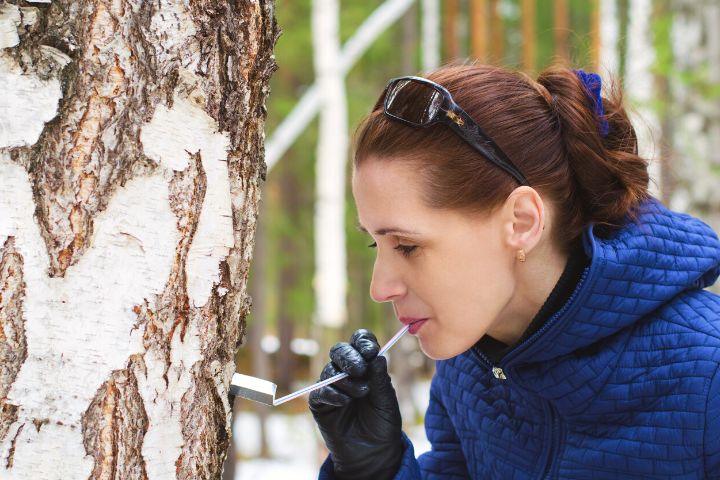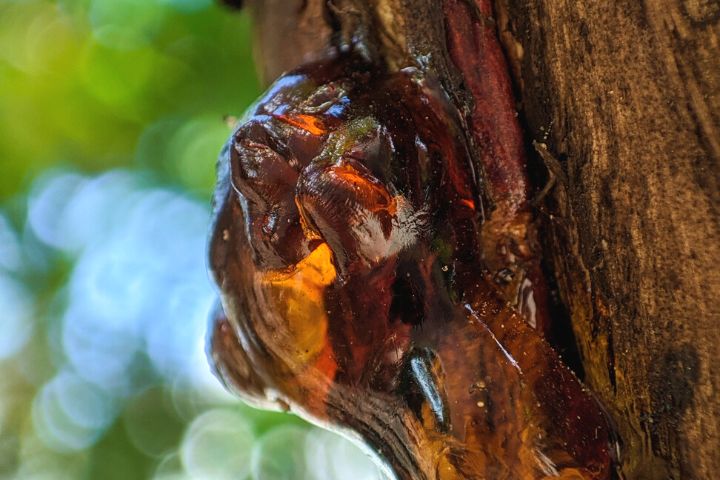What Is Tree Sap | Is it safe?
Tree sap, also known as tree exudate, is a liquid that is produced and secreted by trees. It is often in the form of a sugary water substance that flows through the vascular systems of plants. It can be found in shrubs and other woody plants and plays an important role in the health and well-being of these plants. It can also be used to make products such as syrup and sugar.
What Is Tree Sap Made of?
Tree sap is made of a variety of substances, including amino acids, hormones, and complex carbohydrates such as glucose, fructose, and sucrose.
Tree sap is generally clear or slightly yellowish in color, with a syrupy consistency.
Where Do You Find Tree Sap?
Sap is typically found in the tree’s bark and leaves, and can be collected by tapping the tree. This is a common practice for producing maple syrup, which is made by boiling down tree sap until it becomes syrup. Tree sap can also be found in other products, such as rubber, resin, and turpentine, which are made from the sap of certain trees.
Almost all trees produce some amount of sap, but some species are more inclined to produce large quantities. These include maples, birches, elms, and oaks. Tree sap can be found in most climates, although it is more common in warmer climates.
It is important to note that these trees must be tapped in order to collect the sap, and they should only be tapped by an experienced and knowledgeable person.
Is Tree Sap Beneficial to the Environment?

There are several ways in which tree sap can be beneficial to the environment:
- Trees produce oxygen through the process of photosynthesis, and the sap that they produce helps to transport the sugars that are produced during this process to other parts of the tree. This helps to support the tree’s overall health and growth.
- Tree sap can also serve as a food source for various animals and insects, including birds, bees, and butterflies.
- Some types of tree sap can be used to make natural and organic products, such as rubber, resins, and essential oils. These products can be used as alternatives to synthetic materials, which may have negative environmental impacts.
- Tree sap can also play a role in the ecosystem by helping to support the growth of other plants. For example, when tree sap is secreted from the roots of a tree, it can provide nutrients to nearby plants and improve the overall health of the soil.
Overall, tree sap can have a positive impact on the environment by supporting the growth and health of trees, providing food and other resources for animals and insects, and serving as a natural and sustainable alternative to synthetic materials.
What Does Tree Sap Do?
One of the primary purposes of tree sap is to provide the tree with a source of energy. Trees need a constant supply of energy to support their growth, repair, and other vital functions. This energy is derived from the sugars that are produced during photosynthesis, a process in which trees use light energy from the sun to convert carbon dioxide and water into glucose and oxygen.
The sap that is produced by trees is primarily composed of water and sugars, which are transported from the leaves, where photosynthesis occurs, to the rest of the tree through a network of tubes called xylem vessels. These vessels are located within the tree’s vascular system, which also includes phloem tubes that transport amino acids and other nutrients throughout the tree.
In addition to providing energy and nutrients, tree sap also plays a role in the tree’s defense system. Some trees produce sap that is toxic to certain insects or animals, which helps to protect the tree from damage or infection. For example, the sap of some species of pine trees contains terpenes, which have a strong, resinous smell that is attractive to some insects but also serves as a deterrent to others.

Tree sap is an essential component of a tree’s overall health and well-being. It helps to nourish the tree and keep it strong while also protecting it from potential harm. Without tree sap, trees would not be able to survive.
Is Tree Sap Dangerous?
There are risks associated with tree sap – while not poisonous or toxic, it can cause skin irritation if it gets on your skin or in your eyes. In some cases, it can cause an allergic reaction.
When working with tree sap, it is important to wear protective clothing such as gloves and long sleeves to avoid contact with the skin. It is also important to wash any areas that have been exposed to the sap with soap and water as soon as possible.
Tree sap may contain bacteria or fungi that can cause illness if ingested in large quantities. It can also be corrosive to certain surfaces if left on for too long.
Is Tree Sap Edible?
Tree sap is a good source of essential vitamins and minerals such as Vitamin C and magnesium. It also contains antioxidants that can help protect against disease. Tree sap can be used to make syrup or sugar, or it can be boiled down into a thick concentrate and used as a sweetener in baking or cooking.
What Are the Benefits of Tree Sap to Our Health?
Tree sap can be used as a natural sweetener that contains essential vitamins and minerals. It can also be used to promote healing by stimulating circulation and relieving inflammation. To use tree sap to promote health can be used topically as a salve for cuts and scrapes, or it can be ingested as a natural sweetener for food and drinks. Consuming tree sap may provide a number of health benefits including increased energy levels and improved digestion.

Reiterating the importance of tree sap in sustaining the environment, tree sap plays an important role in sustaining the environment by providing essential nutrients to plants and animals. It can also be used as a natural sweetener that contains essential vitamins and minerals.
What Are the Different Kinds of Tree Saps?
There are many different types of tree saps – the specific types of sap found in a tree can vary depending on the species of tree. Some common types of tree sap include:
- Maple sap: Maple sap is produced by maple trees and is most commonly collected to make maple syrup. Maple syrup is made by boiling the sap down until it becomes syrup. Maple sap is high in sugar content and has a sweet taste.
- Pine sap: Pine trees produce sap that is used to make turpentine, which is a solvent and cleaning agent. Pine sap is also used in the production of resin, which is used in a variety of products such as adhesives, paints, and varnishes.
- Gum sap: Gum sap is produced by gum trees and is a thick, sticky substance that is used in a variety of products, such as adhesives, inks, and cosmetics. Gum sap is also used in the production of rubber.
- Balm of Gilead sap: Balm of Gilead sap is produced by the Balm of Gilead tree, which is native to North America. The sap is used in traditional medicine to treat a variety of ailments, including colds and sore throats.
- Acacia sap: Acacia trees produce sap that is used in the production of gum arabic, which is a substance that is used as a thickening agent in a variety of products, including candies, beverages, and pharmaceuticals.
FAQs
Is Tree Sap Harmful to Animals?
If ingested in large quantities, tree sap can cause harm to animals and plants. It can also be corrosive to certain surfaces.
What is the Difference Between Tree Resin and Tree Sap?
Tree resin is a sticky, translucent substance that is excreted by trees when they are injured or under attack by pests. It is different from tree sap, which is a sugary liquid that flows through the plant’s vascular system.

How Can You Tell the Difference Between Tree Resin and Tree Sap?
- Composition: One way to differentiate between tree resin and tree sap is by examining their composition. Tree resin is composed of a mixture of organic compounds, including terpenes and other volatile oils. Tree sap, on the other hand, is composed of water, sugars, and other organic compounds.
- Appearance: Another way to differentiate between tree resin and tree sap is by their appearance. Tree resin is typically a thicker, more solid substance than tree sap, which is a clear, sticky fluid.
- Location: Tree resin is typically found in the bark and leaves of trees, while tree sap is produced in the tree’s vascular system and can be found throughout the tree.
- Collection methods: Tree resin is typically collected by making incisions in the bark of the tree, while tree sap is collected by tapping the tree.
Is Tree Sap Bad for Our Clothes?
Tree sap can be difficult to remove from clothing as it can stain fabrics and harden over time. If left untreated, it can permanently damage fabric fibers and ruin clothing items.






